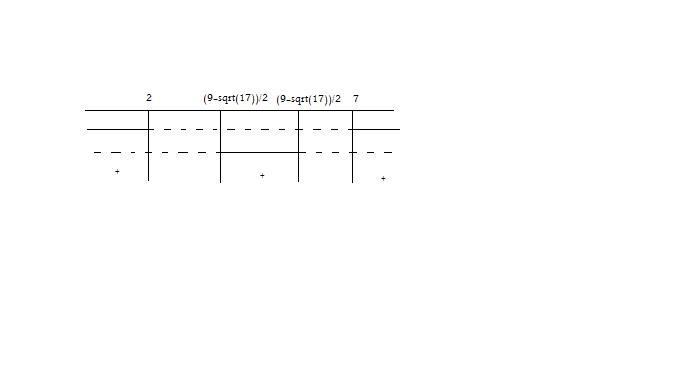[math]|x^2-9x+15|>1[/math]
[math]|x^2-9x+15|>1[/math]
La disequazione è equivalente alle due
disequazioni:
[math]x^2-9x+15>1 _ x^2-9x+15>-1[/math]
.
che possiamo mettere a sistema
[math]\begin{cases} x^2-9x+15>1 \\ x^2-9x+15>-1 \ \end{cases}[/math]
;
Risolviamo il seguente sistema
[math]\begin{cases} x^2-9x+15>1 \\ x^2-9x+15>-1 \ \end{cases}[/math]
;
[math]\begin{cases} x^2-9x+14>0 \\ x^2-9x+16>0 \ \end{cases}[/math]
;
Studiamo singolarmente le due disequazioni
1)
[math]x^2-9x+14>0[/math]
[math]\Delta=b^2-4ac=(-9)^2-(4 \cdot 14 \cdot 1)=81-56=25[/math]
[math]x_{1,2}=(-b+-\sqrt{\Delta})/(2a)=(9+-\sqrt(25))/2=(9+-5)/2 \Rightarrow x_1=2 ^ x_2=7[/math]
.
Siccome il coefficiente di
[math]x^2[/math]
e il segno della disequazione sono concordi,
prenderemo come soluzione accettabile l'intervallo esterno,
per cui la soluzione sarà:
[math]x>2 _ x>7[/math]
.
2)
[math]x^2-9x+16>0[/math]
[math]\Delta=b^2-4ac=(-9)^2-(4 \cdot 16 \cdot 1)=81-64=17[/math]
[math]x_{1,2}=(-b+-\sqrt{\Delta})/(2a)=(9+-\sqrt(17))/2 \Rightarrow x_1=(9+\sqrt(17))/2 ^ x_2=(9-\sqrt(17))/2[/math]
.
Siccome il coefficiente di
[math]x^2[/math]
e il segno della disequazione sono discordi,
prenderemo come soluzione accettabile l'intervallo interno,
per cui la soluzione sarà:
[math](9-\sqrt{17})/2>x>(9+\sqrt{17})/2[/math]
.
Poichè dobbiamo considerare l'unione delle due soluzioni, si ha

Pertanto la disequazione è verificata per
[math]x>2 _ (9-\sqrt{17})/2>x>(9+\sqrt{17})/2 _ x>7[/math]
.








 Accedi a tutti gli appunti
Accedi a tutti gli appunti
 Tutor AI: studia meglio e in meno tempo
Tutor AI: studia meglio e in meno tempo